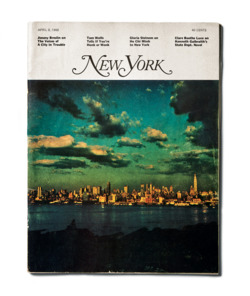 |
New York’s first issue was dated April 8, 1968. While it was still on newsstands, Martin Luther King Jr. was shot and killed. Two weeks after that, Columbia University students rioted and occupied five campus buildings. In the decades since, New York — the city and the magazine — has lived multiple lives. But here is what the magazine’s founding editor, Clay Felker, said 50 years ago in his mission statement for the launch: “We want to attack what is bad in this city and preserve and encourage what is new and good. We want to be its voice, to capture what this city is about better than anyone else has.”
The issue is the first of two, bracketing our anniversary year. (The next will appear in October 2018.) It returns to Felker’s original mission, attempting to capture the city’s voice. The stories in its pages are spoken as much as written, often in dialogue. Under the broad theme “My New York,” we’ve included memories by some New Yorkers you’ll recognize and some you won’t. Larry Gagosian talks about trading a Brice Marden painting for a loft; a Satanist frets over what to say when an adherent asks how to sell his soul; a bartender tells of the patron who plotted ways of killing his dogs. We’ve eavesdropped on some scenes — a knitting circle, a sex party, a Bay Ridge beauty salon — and contrived our own, such as inviting a few prominent New Yorkers to visit their old apartments and meet the current occupants.
And we’ve conducted a few experiments. Curious about what’s going through the head of the subway stranger we can’t stop staring at, we boarded an R train and talked to everybody who’d talk to us. We played Six Degrees of Kevin Bacon, but we went to 50 degrees, starting (for no good reason beyond that he’s the face of New York 1) with Pat Kiernan, and somehow got to Jeremy Lin and a girl in utero. This last editorial game gets at a secondary theme of the issue: that the connections we have with fellow New Yorkers — close or glancing or in our imaginations — create our urban experience. In the margins, you’ll see some of the odd ways the issue’s participants link to one another. “My New York” is told mostly in the first person, and occasionally in competing first-person. (Martha Stewart is not a fan of the way her former home has been renovated.) Throughout, our contributors have explored the places where disparate lives intertwine and sometimes clash, powering a city that has been, for the 50 years of this magazine’s existence, the capital of the world. At least we think so. “You want to participate in this city,” Felker wrote in his manifesto, “because it is alive.” Still true.